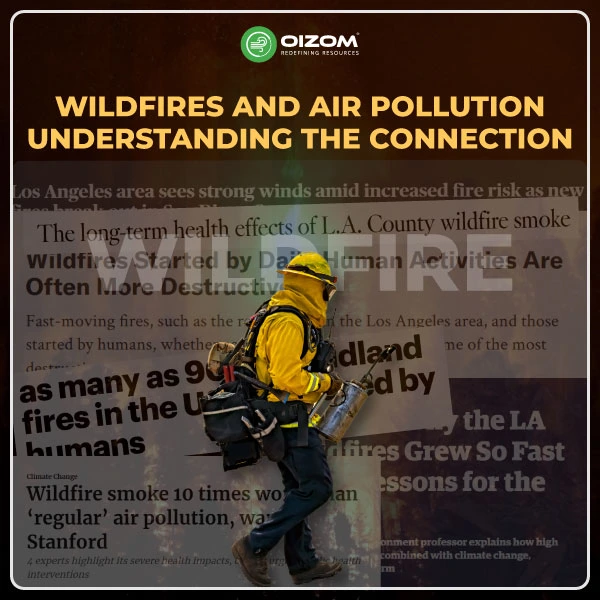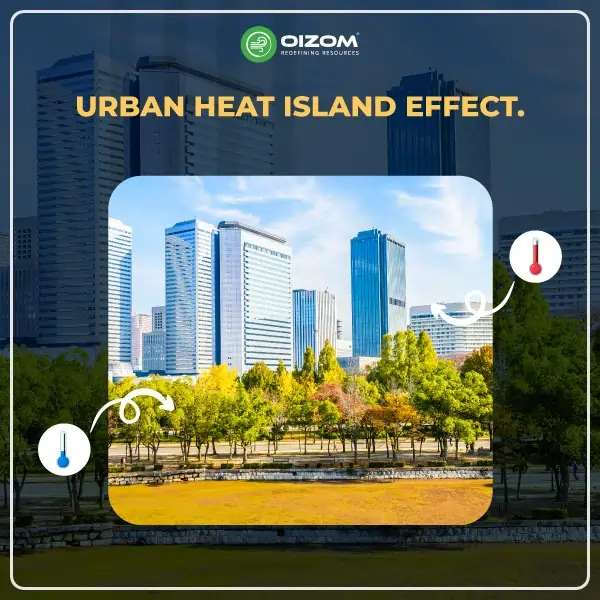When discussing air pollution, we often think of human activities like transportation and industry. But did you know the environment itself can release pollutants into the atmosphere? One major natural contributor is wildfires. Wildfires have been making headlines globally, with California and Los Angeles frequently in the spotlight. If you’ve searched online or tuned into the news, you’ve likely come across questions like: “What’s causing the California wildfires?” or “How did the latest LA wildfire start?“
These intense events aren’t just stories; they’re massive environmental disruptions. In 2023 alone, wildfires scorched over 9.8 million acres across the western U.S., Alaska, and Canada, according to the National Interagency Fire Center. Beyond the devastation to ecosystems, they release enormous quantities of particulate matter (PM) and greenhouse gases, significantly impacting air quality, human health, and the global climate. Let’s dive into the technical aspects of how wildfires contribute to air pollution and why understanding them is critical.
Understanding the connection between Air Pollution and Wildfires
Air pollution, climate change, and wildfires are closely connected, forming a harmful cycle that impacts people, animals, and the planet. Human activities like burning fossil fuels and industrial processes release greenhouse gases, trapping heat and raising global temperatures. This increases the chances of wildfires as hotter temperatures and unpredictable weather create ideal conditions for them.
Wildfires don’t just result in climate change; they also make it worse. Burning trees and plants releases large amounts of carbon dioxide, fine particles, and harmful chemicals, worsening air quality and adding to climate problems. Droughts, linked to climate change, make forests drier and more likely to catch fire.
Wildfire smoke releases pollutants like smog and fine particles that harm air quality and public health, causing respiratory issues and long-term environmental damage. This cycle keeps repeating, making wildfires more frequent and severe.
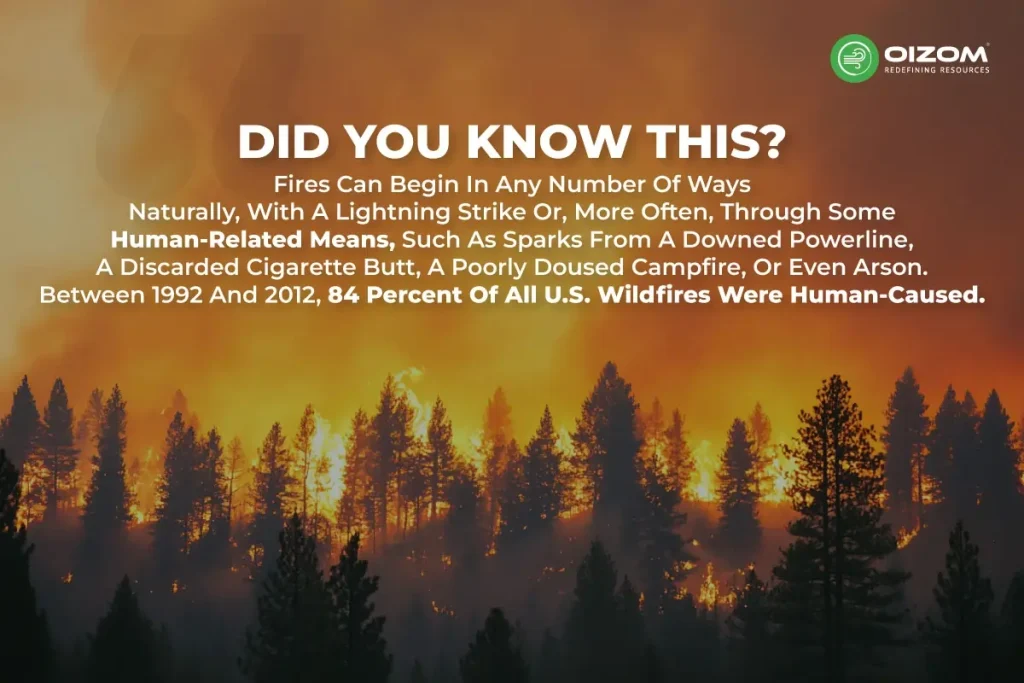
Dangers of wildfire smoke
Wildfire smoke contains a range of harmful pollutants, with particle pollution being one of the most concerning. This pollution consists of microscopic solid and liquid particles suspended in the air, many of which are smaller than one-third the diameter of a human hair. Due to their extremely small size, these particles can penetrate deep into the respiratory system, reaching the lungs and even entering the bloodstream.
Exposure to particle pollution from wildfire smoke is linked to serious health effects, including exacerbation of asthma, increased risk of heart attacks and strokes, and even premature mortality. Studies conducted in California have shown that children exposed to wildfire smoke experienced higher rates of respiratory issues, such as coughing, wheezing, bronchitis, and colds, leading to increased doctor visits and hospitalizations, particularly for asthma-related complications.
Another significant pollutant in wildfire smoke is carbon monoxide (CO), a colorless and odorless gas that is most prevalent during the smoldering phase of a fire and in areas close to the fire source. Inhalation of CO impairs oxygen transport within the body, which can result in symptoms such as headaches, nausea, dizziness, and, in severe cases, can lead to life-threatening conditions.
In addition to particle pollution and carbon monoxide, wildfires release other hazardous air pollutants, including nitrogen oxides (NOₓ) and a variety of toxic compounds that further degrade air quality and pose risks to public health. Addressing wildfire emissions is crucial to mitigating their environmental and health impacts.
Health Impacts of Wildfire Smoke
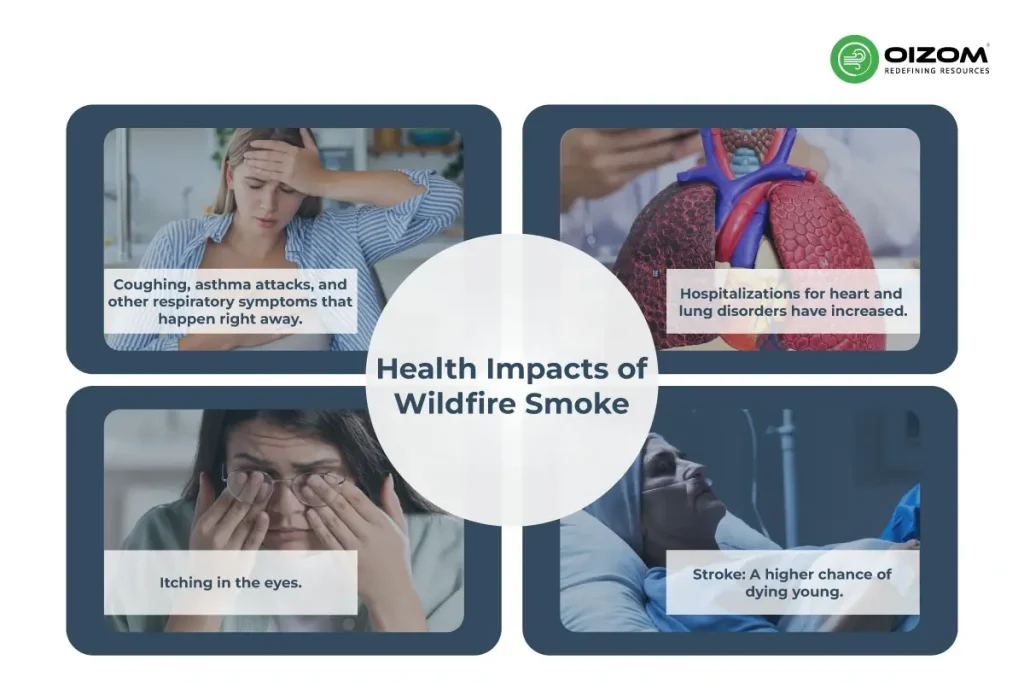
Although we are aware that wildfires and the smoke they produce have detrimental effects on human health. However, there isn’t much long-term research examining these effects over time. To completely understand all the ways that wildfires impact long-term health outcomes, researchers are still working.
Hazardous pollutants found in wildfire smoke, such as heavy metals, benzene, and small particulate matter, can enter the bloodstream and lungs deeply. Were you aware of this?
According to Jessica Yu, a research scientist at the Stanford Woods Institute for the Environment’s Climate and Energy Policy Program, these toxins can damage multiple body systems, including the cardiovascular and nervous systems.
The more well-known health effects of wildfire smoke include short-term effects, especially those on the respiratory system, such as:
- Coughing, asthma attacks, and other respiratory symptoms that happen right away.
- Hospitalizations for heart and lung disorders have increased.
- Itching in the eyes.
- Stroke: A higher chance of dying young.
These short-term effects are well documented, but as wildfire seasons get more severe every year, it’s critical to learn more about the long-term health effects of wildfires.
Long-term exposure to wildfire smoke causes systemic inflammation, which can subsequently lead to life-threatening illnesses and chronic conditions, including heart disease.
The respiratory system is most obviously affected by wildfire smoke, but the body as a whole is impacted by its emissions. According to research, diabetes, dementia, and other diseases may be exacerbated by air pollution.
Furthermore, carcinogens such as polycyclic aromatic hydrocarbons and aldehydes are produced by wildfires. Smoke from wildfires has also been shown to contain mercury, a recognized toxin that can lead to visual issues, speech disorders, and muscular weakness. The global estimate for premature deaths attributed to wildfires is over 339,000 every year.
Human health is impacted by wildfires not just while they are burning but also throughout the cleanup effort. Hazardous materials, including the dangerous mineral asbestos, which may be found in older dwellings, are exposed by the debris left over after homes and structures have burned during a wildfire. The long-term effects of wildfires, particularly on human health, require further research, even though we have a solid understanding of their immediate effects. For example, we need to know if prolonged exposure to wildfire smoke causes the development of diseases like cancer, diabetes, or heart disease.
How wildfires affect the environment
Wildfires have the potential to seriously harm habitat in the short term, especially when they burn vegetation. Smaller trees and plants near the forest floor are frequently destroyed by fires, depriving many animals of their homes and food sources. After the fire damage, plants that can withstand the fires, like larger trees whose branches the flames cannot reach, may become more vulnerable to insects, fungi, and disease.
Did you know this? In 2020, California hosted its worst fire season on record, and IFAW was on the ground responding to the North Complex fires, which were burning at a rate of 1,000 acres every 30 minutes. They worked with partners to rescue and care for horses, dogs, cats, and goats… 590 animals in total amidst a global pandemic.
When vegetation is lost, the soil may become hydrophobic and unable to absorb water, which increases the amount of trash and pollutants that can wash into bigger bodies of water during storms. Heavy metals from ash and soil can enter streams through flash floods, which can also happen after fires. Water sources, including streams, rivers, and lakes, can undergo physical, chemical, and biological changes as a result of wildfires, and these changes can be observed for years or even decades after the fire.
One area that is obviously greatly harmed by wildfires is forest health. This century has seen a sharp decline in tree regeneration rates, and severe forest destruction can even cause ecosystems to shift, with forests becoming grasslands or shrubs. Let’s take a look at global headlines about the recent LA wildfires that started on January 7, 2025, and explore their causes and effects.
Understanding the Recent LA Wildfires: Simple Causes, Effects, and Recovery Steps
As per the BU Today, Los Angeles is beginning to recover from the devastating wildfires that have claimed 25 lives, displaced 100,000 people, and caused damages worth billions. As officials investigate the cause, ranging from arson and power line sparks to fireworks, experts suggest that natural factors, such as strong winds, are more likely than arson.
Regardless of the exact cause, scientists agree that the weather and climate conditions on January 7th, 2025, created the perfect environment for the fires to spread rapidly. Ongoing strong winds continue to pose a serious threat to the city, keeping the risk of further destruction high.
With over 23,000 acres burned and nearby villages damaged, the Palisades fire was the first to break out and the most contained. In California history, the Palisades and Eaton fires are both considered to be among the deadliest and most devastating. And with additional strong winds predicted, the toll is predicted to rise.
Why have these Los Angeles fires spread so fast?
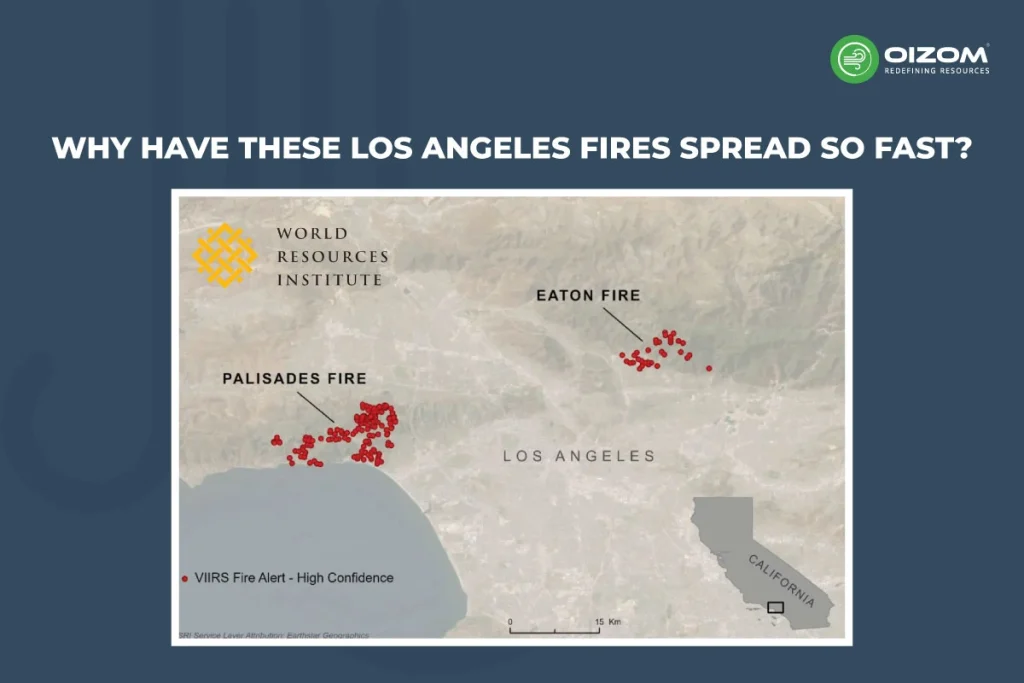
Los Angeles is facing a weather pattern known as “Santa Ana winds,” which brings strong, dry winds that create extreme fire risks. These winds are common in Southern California during late autumn and winter. They occur when high pressure builds over inland areas, creating a temperature difference between the cooler deserts of Nevada and Utah and the warmer Southern California coast. This pressure difference drives strong winds from the mountains toward the coast, which become even stronger as they pass through narrow mountain valleys.
Santa Ana winds make wildfires more dangerous by fueling flames, causing them to burn hotter, spread faster, and making firefighting efforts more challenging. Strong winds can prevent the use of aerial firefighting resources, such as helicopters and tanker planes, to drop water and fire retardants.
Under these conditions, the Eaton Fire in the San Gabriel Mountains, east of Pasadena, rapidly expanded, growing twenty times in size within hours, as reported by the New York Times.
Wildfires in California are increasing.
Although these early-season fires are uncommon, during the past 20 years, forest fires in general have become more destructive for Californians, endangering cities and lives from San Diego in the south to Napa County in the north.
Wildfires are the leading cause of tree cover loss in California. In 2020 and 2021 alone, the state lost a record 700,000 hectares (1.73 million acres) of forests, an area more than five times the size of Los Angeles. These fires had devastating effects, resulting in loss of lives, dangerous air pollution, destruction of ecosystems, and billions of dollars in property damage.
How much is climate change to blame for these fires?
While climate change plays a role in wildfires, it’s not the only factor. Natural events like heavy rainfall that boost vegetation growth, droughts, and strong Santa Ana winds have always occurred. Additionally, past fire suppression strategies and the risk from aboveground power lines contribute to both the outbreak and intensity of wildfires.
Focusing solely on climate change can feel overwhelming, as it suggests that reducing emissions is the only solution. However, there are practical steps that can help reduce wildfire risks and impacts. These include managing vegetation to lower fuel loads, avoiding construction in fire-prone areas, using fire-resistant building materials, and creating defensible spaces around homes.
Improving evacuation plans and preparedness is also crucial to ensure people can escape safely without blocking emergency response efforts. Taking these proactive measures can make wildfires less destructive and improve overall community safety.
Effects of Wildfire in LA
Wildfire smoke is being inhaled by millions of people in the Los Angeles region as burns rage through houses and cars. Building materials, furnishings, paints, plastics, electronics, and other items were all destroyed in the January 2025 flames, which also destroyed hundreds of buildings. These kinds of materials have the potential to release harmful compounds into the air as they burn, which could endanger those who breathe it in.
EPA data shows that during the height of the flames, several million people in the Los Angeles area saw two days of strong smoke that caused air quality to be in the red “Unhealthy” zone, with higher levels in the “Hazardous” range near the fires. Only the PM2.5 (particles with a diameter of 2.5 millimeters or smaller) particles that the EPA tracks are included in these air quality ratings. The extremely poisonous makeup of the smoke from the urban aspect of these fires was not taken into consideration when the air quality was rated as “Unhealthy” last week.
According to a 2023 study, smoke from fires in the wildland-urban interface, areas where urban communities transition into wildlands, contains a wide range of toxins that are dangerous to people. They consist of dioxins, hydrogen chloride, polycyclic aromatic hydrocarbons, and a variety of hazardous organic substances, such as benzene, which is known to cause cancer, as well as toluene, xylenes, styrene, and formaldehyde. Metals, including lead, chromium, cadmium, and arsenic, which are known to impact various body systems like the brain, liver, kidney, skin, and lungs, were also discovered by the researchers in the smoke. The short-term effects of exposure to smoke like this can trigger asthma attacks and cause lung and cardiac problems.
Data from the Copernicus Atmospheric Monitoring Service (CAMS) reflects the scale of the fires, showing they have already released significant amounts of carbon and air pollutants emissions, with potential environmental impact and health risks.
A potential analog situation occurred during the 2018 Camp Fire that burned over 18,000 structures in Paradise, California. Significant increases in both lead and zinc occurred in the air. The presence of lead is particularly concerning because lead exposure has been linked to high blood pressure, reproductive effects, and cancer. Infants and young children are especially sensitive to low levels of lead that are known to cause behavioral changes and learning deficits. Wildfire smoke also contains toxic carcinogens similar to those found in cigarette smoke.
Economic loss due to wildfire in LA
According to a recent AccuWeather analysis, climate change is contributing to the frequency and severity of some of the most expensive natural disasters in over a century, which have occurred in the past year. The human and economic costs have been enormous, ranging from back-to-back storms in Florida and the Southeast to wildfires in Southern California.
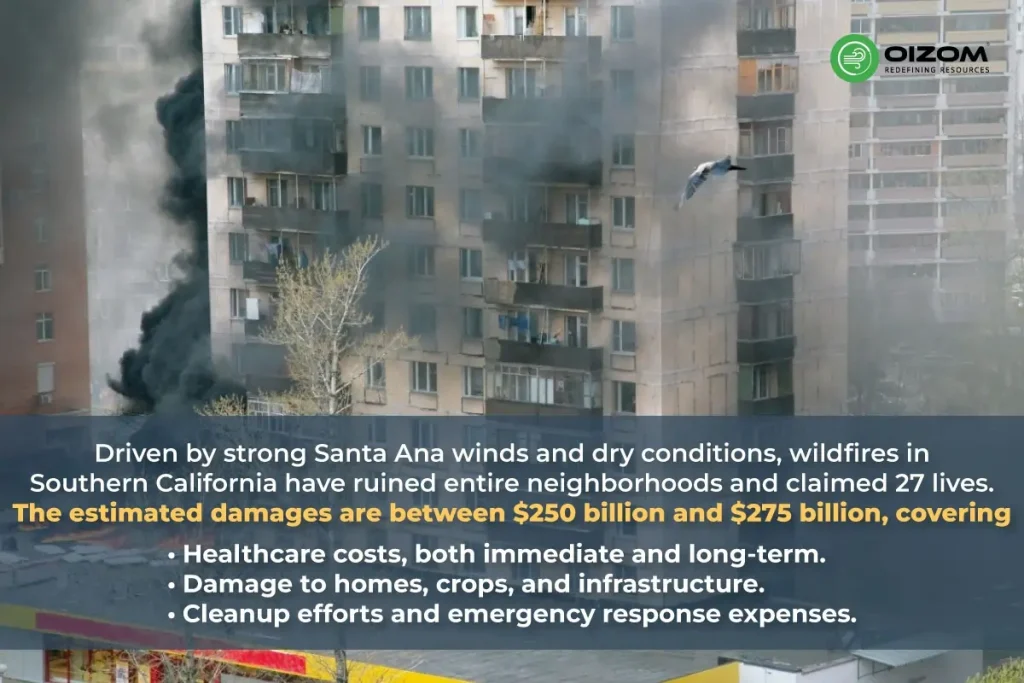
- Healthcare costs, both immediate and long-term.
- Damage to homes, crops, and infrastructure.
- Cleanup efforts and emergency response expenses.
These fires have also sparked economic concerns, including falling property values, lower tax revenue, and residents relocating to states with fewer wildfire risks and lower taxes.
At the same time, hurricanes Helene and Milton dumped over 40 trillion gallons of rain on the Southeast, causing 100 deaths in North Carolina alone. These disasters highlight how climate change is intensifying extreme weather events, making them more frequent and severe.
According to AccuWeather founder Dr. Joel N. Myers, the combination of California’s wildfires and recent hurricanes marks the worst series of natural disasters in the U.S. since the 1930s Dust Bowl.
Tips to Protect Public Health
The wildfires in Southern California are creating dangerous air pollution that can harm your health. If you are in the affected area, stay updated with police and fire department alerts, and follow all safety instructions. Once you’re safely away from the fire, these tips can help protect your lungs from the harmful smoke and poor air quality.
If you’re not directly affected but want to help, share this information with those in need. And if you live in an area at risk of wildfires, being informed now can help you stay prepared for the future.
Key takeaway: Breathing wildfire smoke is harmful for everyone, but certain groups are at higher risk. These include people with asthma, COPD, heart disease, or diabetes, as well as children, seniors, and pregnant women.
Tips to Protect Your Health During Wildfires
- Follow evacuation orders: Stay updated with alerts from the National Weather Service or your local power company by signing up for emergency notifications.
- Travel safely: Keep car windows closed, use the air conditioner, and set it to recirculate air.
- Prepare essentials: Pack medications, prescriptions, and insurance cards in case you need to leave. If you have asthma or COPD, keep your medications and action plan ready.
- Stay indoors: Keep doors, windows, and vents closed. Create a clean room in your home with better air quality.
- Use your AC wisely: Set it to “recirculate” mode to reduce smoke exposure. Consider using an air purifier with a HEPA filter for added protection.
- Watch for symptoms: If you experience wheezing, shortness of breath, or other health issues, contact your doctor. Symptoms can appear immediately or even days after exposure.
- Use the right mask: N-95 masks can help filter smoke particles if fitted properly. Regular medical or dust masks won’t protect you from harmful gases.
- Consider relocation: If you have lung conditions or other health risks, you may need to move to a safer location, even without an evacuation order.
- Monitoring Air Quality: Using Oizom’s Polludrone and Pollusense, you can monitor air quality in real-time and get accurate data on harmful gases, particulate matter, and weather conditions. These devices effectively track wildfire smoke by measuring key pollutants. They provide immediate air quality updates, helping you stay informed and take timely action to protect your health.
Conclusion
Wildfire smoke presents significant risks to public health, the environment, and the economy, both during and after the fire. The Palisades Fire, first reported on the morning of January 7, rapidly expanded to nearly 3,000 acres within 24 hours, driven by strong Santa Ana winds and necessitating widespread evacuations.
Wildfires like these impact far beyond the immediate destruction they cause. They not only endanger human health and safety but also lead to significant economic setbacks, loss of biodiversity, and destruction of infrastructure. The loss of animal habitats and the disruption of ecosystems have long-term consequences for environmental sustainability. The financial burden on governments to manage these crises and rebuild after the damage diverts resources from developmental initiatives, slowing the overall growth of affected nations.
Furthermore, ongoing investigations are still determining the exact cause of the wildfire. However, understanding the air quality impacts of such events requires a comprehensive and well-distributed monitoring network.
Effective air quality management relies on accurate, localized data, emphasizing the principle that “you can’t manage what you can’t measure.” Without real-time, high-resolution air quality data, assessing the true impact of wildfire smoke on individuals and communities becomes challenging. Existing air quality monitoring infrastructure often faces challenges during wildfire events, including sensor outages and data gaps, which hinder the ability of officials and residents to make timely and informed decisions for health protection.
To address these challenges, deploying a resilient air quality monitoring network with redundancy, adaptive sensor placement, and real-time reporting capabilities is essential. Advanced technologies like IoT-enabled sensors, satellite data integration, and machine learning-driven predictive modeling can enhance wildfire smoke impact assessment.
Oizom’s advanced air quality monitoring solutions offer a robust approach to this challenge by providing real-time, hyperlocal air quality data with high accuracy. Oizom’s devices, such as Polludrone and Pollusense, are designed to operate in extreme conditions, ensuring continuous monitoring even during wildfire events. By leveraging Oizom’s comprehensive monitoring systems, stakeholders can better mitigate health risks, guide evacuation strategies, and support long-term environmental and economic resilience in wildfire-prone regions.
FAQs
Wildfires release harmful pollutants like tiny particles (PM2.5, PM10), gases such as carbon monoxide (CO), carbon dioxide (CO₂), and nitrogen oxides (NOₓ). These make the air unhealthy and cause widespread pollution.
Wildfires emit particulate matter (PM2.5, PM10), carbon monoxide (CO), carbon dioxide (CO₂), nitrogen oxides (NOₓ), sulfur dioxide (SO₂), black carbon, methane (CH₄), and volatile organic compounds (VOCs).
Smoke from wildfires can travel thousands of kilometers with the wind, spreading pollution to far-off areas. This affects air quality, health, and even weather patterns in those regions.
In the short term, it can cause coughing, irritation, and breathing problems. Long-term exposure increases the risk of lung diseases, asthma, and heart problems.
Stay indoors with windows closed, use air purifiers, wear N95 masks outdoors, and check air quality updates regularly to avoid exposure.
Air quality is tracked using satellites, ground sensors, IoT devices, and real-time mapping tools powered by artificial intelligence (AI).
Wildfires release greenhouse gases like CO₂ and methane, which contribute to global warming. Smoke particles can also temporarily affect weather patterns.
Policies focus on better forest management, controlled burns to reduce fire risks, and air quality standards to limit pollution impacts.

